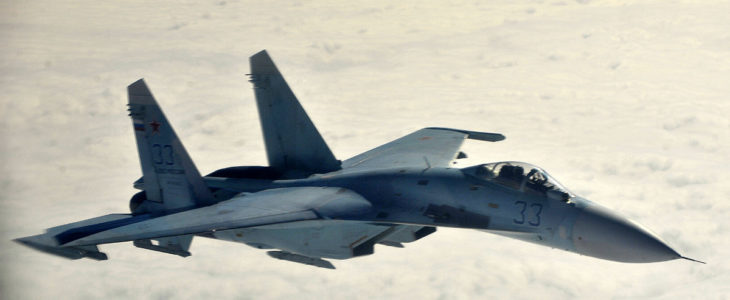The Sukhoi SU-27 Air Superiority Fighter

The Sukhoi Su-27 was released in 1985 as the Soviet response to an extremely aggressive class of fourth generation air superiority fighters released by the United States — namely the F-14 Tomcat and the F-15 Eagle.
Both aircraft were exceptionally fast, could carry and intense air-to-air payload, and stay in the sky for long periods of time. The Su-27, referred to by NATO as the Flanker, was meant to compliment the long-running MiG-29. In many ways the Su-27 has proven itself as more than a match for the F-15 Eagle and has surpassed expectations in terms of performance and thrust-to-weight ratio. The biggest question, though, is whether it is a match for the F-22 Raptor.
Heavily Upgraded Legacy Fighter:
With an evolving generation of fifth generation multirole jet fighters like the F-22 Raptor and the F-35 Lightning II, an aging fleet of extremely nimble Su-27s may have met their match. For Flanker enthusiasts, the Su-27 has undergone many structural upgrades to its avionics and the current version is known as the Su-27SM3. This Su-27SM3 is meant to bridge the gap until a much more advanced Sukhoi PAK FA stealth fighter can take over.

Generation Fighters:
When it comes to how the F-35 Lightning II would match up against existing fourth generation fighters, we need look no further than how it fared against an aged F-16C. In January, 2014, the Department of Defense released a report that noted the F-35 could not endure in an air-to-air engagement with an F-16C.
“Overall, the most noticeable characteristic of the F-35A in a visual engagement was its lack of energy maneuverability,” the report states. “Even with the limited F-16 target configuration, the F-35A remained at a distinct energy disadvantage for every engagement.”
Cost Effective Counters:
General Joseph F. Dunford Jr., USMC, gave a statement on July 9, 2015, where he questioned the purchase order of the F-35 because of threats he saw with the emerging generation of jet fighters being produced by potentially hostile nations. From this, we can begin to infer that the F-35 Lightning II may need significant improvements before it’s mission ready to go up against even fourth generation fighters like the MiG-29 and Su-27.
That leaves the F-22 Raptor. The F-22 Raptor is an impressive air superiority fighter. With a top speed of a little less than 1,500 mph, it is only a little slower than the Su-27SM3. Unfortunately, significant budget constraints limited the number of F-22’s released. Despite procuring only 187 of the aircraft, the United States Air Force sees them as an unmatched air superiority platform. Capable of stealth operation, fantastic aerodynamic performance, and great situational awareness, the F-22 may definitely be a great one-on-one choice against an advanced Su-27SM3.

Mass Production:
The biggest issue facing this battle is numbers. The Russian Federation has more Su-27SM3’s than the United States Air Force has of F-22’s. The F-35 program was given the green light to take over as a primary flagship for the United States’ fifth generation multirole stealth fighter program but it has hit significant obstacles in terms of performance and reliability. The F-22 entered service in 2005 and the last fighter jet to be produced hit the airfield in 2012. The Raptor is ready right now. The F-35 is not.
Future Threats:
As such, we’re looking at a potential conflict space where a reduced number of F-22 Raptors may be faced with numerically superior and equally aerodynamic Su-27’s. This could be ultimately catastrophic. The United States purchased several Su-27 Flankers for use as OpFor (Opposition Force) against their own fighters and naval groups to simulate good defensive strategies. According to Pravda, in one such test, both Su-27’s were able to fly within range of the U.S.S. Kitty Hawk (CV-63). This is theorized to result in the loss of an entire aircraft carrier as the Su-27 is mission capable to carry air-to-ship missiles. While only a test, it definitely demonstrates the dangerous capabilities of these aircraft. It’s one of the reasons why the United States purchased a small number. Su-27’s were repeatedly beating the F-15 in testing and engineers and military planners wanted to know why.
Would this mean the F-22 Raptor would hold up where the F-15 could not?

Performance:
Unfortunately, data at this point is scant. The Su-27 has an extremely brief combat history with the Soviet Union. It has been used effectively by other nations that purchased it such as Ethiopia. Ethiopia even managed to shoot down Eritrean MiG-29’s during a brief war that broke out between the two nations in 1998 to 2000.
Our best guess is that the F-22 Raptor may be a fantastic match against even advanced Su-27SM’s but their lack of numerical superiority may ultimately prove their undoing. Thankfully, the likelihood of running into a situation where the majority of the fleet of each would ever be called into the skies against one another is exceptionally low.
